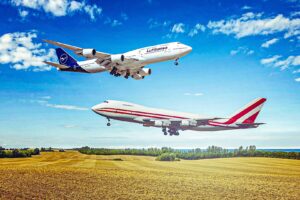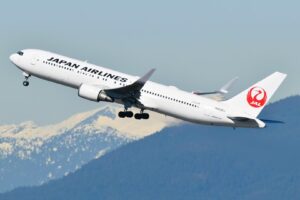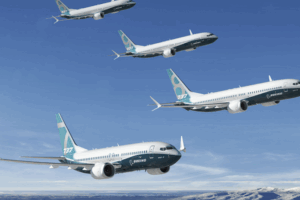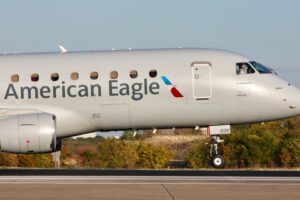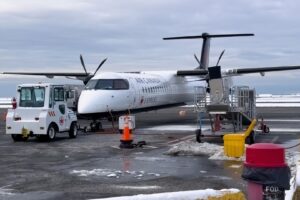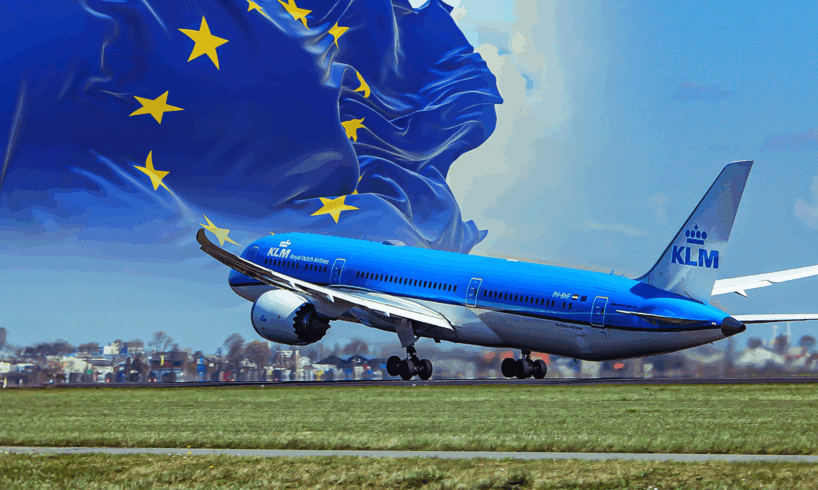
The configuration of a Boeing 787
-9 Dreamliner operated by European airlines can differ significantly from one carrier to another, impacting passenger experience through variations in seating density, cabin class arrangements, and the overall ambiance. Understanding these differences is crucial for travelers seeking specific comfort levels or amenities when flying long-haul routes within or beyond Europe. There is a diverse mix of airlines within Europe that operate the B787-9, signifying this aircraft’s key capabilities to cater to most long-haul carriers.
Boeing 787-9
Length
206 ft (62.8 m)
Wingspan
197 ft (60.1 m)
Height
55 ft 4 in (16.9 m)
European airlines utilize the B787-9 for fuel efficiency and passenger comfort on long-haul flights. However, each airline customizes the aircraft’s interior to align with its brand identity, target market, and operational strategy. This article will delve into the diverse cabin layouts found on European carriers’ B787-9s, highlighting the key variations in seating, class configurations, and passenger amenities to provide clarity for discerning travelers.
The Quick Overview: Varied Seating and Class Configurations
Photo: Doubleclix | Shutterstock
European airlines exhibit considerable variation in their B787-9 cabin layouts. This primarily manifests in the number of seats offered, the configuration and pitch of seats within each class (first, business, premium economy, and economy), and the presence or absence of certain cabin classes altogether. Some airlines prioritize higher density with a greater number of seats, such as Norse Atlantic
, TUI airways
, and Air Europa
. Others focus on enhanced passenger comfort with more spacious layouts, such as Virgin Atlantic
and Air France
.
For example, British Airways’ B787-9, often deployed on long-haul routes to North America and Asia, features a four-class configuration including First, a spacious Club World, World Traveller Plus, and World Traveller. This layout caters to a mix of business and leisure travelers seeking varying levels of comfort on these premium intercontinental journeys. Leisure carrier TUI Airways typically configures its B787-9 fleet with a focus on holidaymakers. Their layouts often feature a distinct premium cabin offering enhanced comfort and amenities for those seeking a more relaxed start to their vacation, alongside a higher-density economy cabin to cater to the broader leisure market.
Airline cabin layouts have long evolved with market demand, seating technology, and airline competition. The modern B787-9 continues this with European carriers significantly customizing interiors to balance passenger comfort and capacity. Data from sources like Aerolopa clearly shows the varying seat counts and pitch across different airlines’ B787-9s, reflecting their diverse operational strategies.
Decoding the Differences: Factors Shaping Cabin Configuration
Photo: KLM
Several key factors drive European airlines’ variations in B787-9 cabin layouts. These include the airline’s target market (business vs. leisure), the length and nature of the routes operated (short-haul feeder flights versus ultra-long-haul), the airline’s brand positioning (budget-friendly to premium), and the specific operational requirements and economic considerations of the airline.
One significant factor is the airline’s target demographic. Carriers heavily focused on business travelers often allocate more space to premium cabins like business and premium economy, offering lie-flat or more spacious seating with enhanced amenities. Conversely, airlines catering to a more price-sensitive leisure market might opt for a higher density configuration in the economy cabin to maximize revenue per flight. Air Europa uses its B787-9s on routes to South America, solidifying its long-haul operations to the continent, rivaling the likes of Iberia and TAP Air Portugal
with its low-cost and simple cabin approach.
Airline
Total B787-9s
First
Business
Premium Economy
Economy
British Airways
18
8
43
39
127
Virgin Atlantic
17
–
31
35
192
Air Europa
15
–
30
32
–
303
307
KLM Royal Dutch Airlines
13
–
30
21
224
Air France
10
–
30
21
228
Norse Atlantic Airways
7
–
–
56
282
LOT Polish Airlines
7
–
24
21
249
Lufthansa
5
–
24
28 (Allegris)
21
28
247
231
TUI Airways
5
–
–
63
282
Austrian Airlines
2
–
26
21
247
Airline branding and operational efficiency are also paramount. A full-service carrier with a premium brand image is more likely to invest in a comfortable and spacious cabin layout across all classes. Meanwhile, airlines focused on operational efficiency might prioritize a higher seat count to achieve economies of scale. For example, Lufthansa
operates multiple configurations of the B787-9, tailored to different route types and passenger demand profiles within its extensive network. Norse Atlantic
Airways, a low-cost long-haul carrier, provides a contrasting example of strategic cabin configuration. Their B787-9 fleet typically features a high-density layout with a primary focus on maximizing the number of seats in their economy and premium economy cabins.
Related
How The Boeing 787-9 Became The Workhorse Of International Routes
New data exemplifies the 787-9’s position as the world’s workhorse for international routes, used by countless carriers.
Strategic Choices: Airlines on the 787-9’s Versatility
Photo: Vincenzo Pace | Simple Flying
European airlines’ decision to incorporate the B787-9 into their fleets is often driven by the aircraft’s inherent flexibility, particularly in terms of cabin configuration and its suitability for a wide range of routes. This adaptability allows airlines to tailor their onboard product to specific market demands and operational needs.
The strategic decision by airline groups like Air France-KLM to operate the B787-9 also highlights this flexibility. While both KLM and Air France might utilize the same aircraft type, their distinct cabin layouts reflect their individual brand strategies and the profiles of their primary passenger bases. KLM might prioritize a strong business class offering for its network connecting major business hubs, while Air France’s configuration could be optimized for a different blend of leisure and business travel.
Airline
Key B787-9 Route
British Airways
London Heathrow (LHR) – Mumbai (BOM)
Virgin Atlantic
London Heathrow (LHR) – Johannesburg (JNB)
Air Europa
Madrid (MAD) – Buenos Aires (EZE)
KLM Royal Dutch
Amsterdam (AMS) – San Francisco (FRO)
Air France
Paris (CDG) – Nairobi (NBO)
LOT Polish
Warsaw (WAW) – Chicago O’Hare (ORD)
Lufthansa
Munich (MUC) – Toronto (YYZ)
TUI Airways
London Gatwick (LGW) – Cancun (CUN)
Norse Atlantic
Oslo (OSL) – New York (JFK)
Austrian Airlines
Vienna (VIE) – New York (JFK)
Furthermore, the B787-9s range capabilities of 7,565 nm (14,010 km) complement this cabin flexibility, allowing airlines to deploy the same aircraft type on both shorter long-haul routes and ultra-long-haul services, with the cabin configured appropriately for the expected passenger mix and flight duration. This inherent adaptability of the B787-9 is a significant factor in European airlines’ fleet planning and route network development.
A Wider Perspective: Comparing 787-9 Layouts to Other Aircraft
Photo: Photofex_AUT | Shutterstock
Compared to narrow-body aircraft or even other wide-body aircraft like the Airbus A350, the B787-9 offers airlines a significant degree of flexibility in cabin configuration due to its size and range capabilities. While some standardization exists within airline alliances or due to market trends, the level of customization seen on European B787-9s highlights a more pronounced divergence in layout strategies compared to aircraft primarily used for shorter or regional routes.
For instance, the cabin layouts on European airlines’ Airbus A320 family aircraft tend to be more standardized, primarily featuring business and economy classes with variations in seat pitch. The long-haul nature of the B787-9, however, necessitates more diverse cabin class options and a greater emphasis on passenger comfort, leading to more significant differences between airlines. structure on their long-haul fleet.
The variations in B787-9 layouts also differ from the more standardized configurations sometimes found on low-cost long-haul carriers, though even these can have nuances. While a budget airline might prioritize a high-density single or dual-class layout, full-service European carriers often differentiate themselves through a wider range of cabin classes and varying levels of seat comfort and amenities. The configurations of airlines like TUI Airways and Virgin Atlantic, both operating B787-9s, further exemplify how network carriers within the same region can adopt distinct cabin philosophies.
Premium vs. Budget Traveler: An Option For Both
Photo: Vincenzo Pace | Simple Flying
While the flexibility of the B787-9 allows European airlines to cater to diverse markets, a notable trend in the long-haul sector is the increasing emphasis on premium cabins like premium economy and business class, particularly among legacy carriers such as British Airways. This shift is driven by a desire to capture higher-yield passengers and offer enhanced comfort on longer routes. However, this trend might create a growing divide, with some airlines potentially falling behind in offering competitive premium options.
For example, while British Airways has actively expanded and refined its premium economy and business class offerings on its B787-9 fleet to attract a more discerning clientele, leisure-focused carriers like TUI Airways or budget long-haul airlines such as Norse Atlantic Airways might prioritize a higher overall seat density with a more limited premium offering. This difference in strategic focus could mean that passengers seeking a consistent and well-appointed premium experience might find fewer options on these latter airlines’ 787-9s as the general trend leans towards enhanced premium travel.
Therefore, passengers should be aware that while the B787-9 offers configuration flexibility, the actual cabin layout they encounter can be significantly influenced by the airline’s strategic priorities and target market. If premium comfort is a key consideration, travelers should specifically investigate the availability and quality of premium economy and business class cabins on their chosen airline’s B787-9, as there’s a risk that some carriers might not align with the broader industry trend of expanding these higher-yield sections.
The Essential Understanding: European B787-9 Cabin Layout
Photo: Vincenzo Pace | Simple Flying
In conclusion, the cabin layouts of B787-9 Dreamliners operated by European airlines exhibit significant diversity. This variation stems from factors such as target market, route strategy, brand positioning, and operational considerations. Passengers can expect to find differences in the number of cabin classes offered, the density and pitch of seating within each class, and the overall amenities provided.
For travelers, understanding these differences is key to selecting flights that align with their comfort preferences and budget. Resources like seat maps and airline reviews can provide valuable insights into the specific configuration of a flight. As European airlines continue to adapt their long-haul offerings, the cabin layouts of their B787-9 fleets will likely continue to evolve, reflecting the dynamic nature of the aviation industry and the varying needs of passengers.
Looking ahead, we might see further differentiation in cabin layouts as airlines explore new ways to segment their markets and enhance the passenger experience. The ongoing competition in the long-haul market will likely drive continued innovation in cabin design and configuration, making it essential for travelers to stay informed about the specific aircraft and airline they choose.
Related
Which Airlines Have The Most Boeing 787-9s In Their Fleet?
The world’s two largest operators of the Boeing 787-9 have 43 of the aircraft in their fleets.

